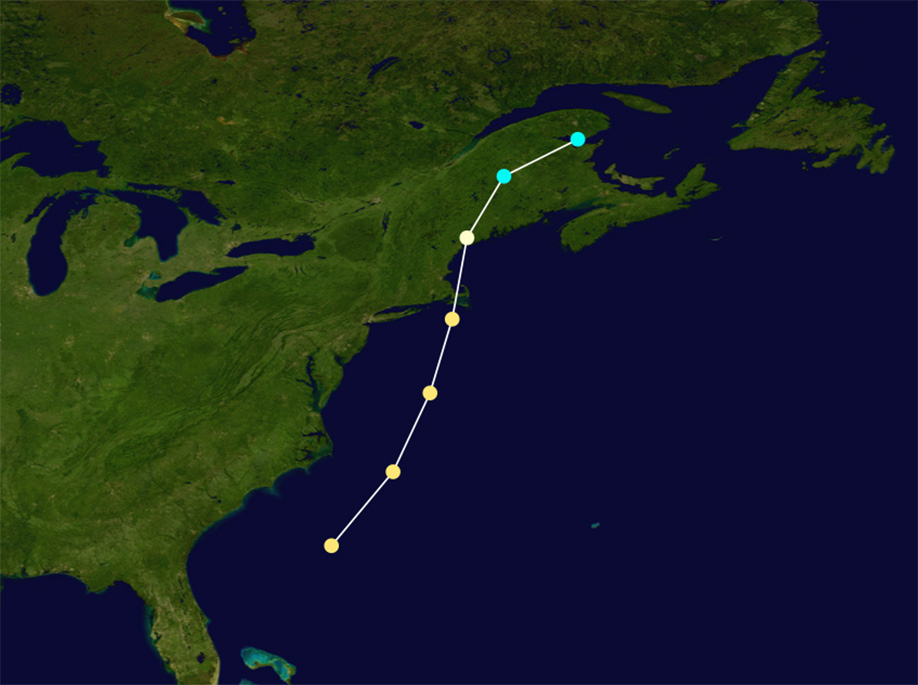
illustration from Wikipedia
The computer-generated track of the 1869 hurricane named The Saxby Gale is found on the Wikipedia page about the hurricane.
by Elizabeth H. Dow, President and Editor of the Hardwick Historical Society Journal
[The following is an excerpt from the Summer 2023 edition of The Hardwick Historical Society Journal, reprinted with permission to provide some historical perspective on recent events.]
HARDWICK — When the Flood of 2023 came to Hardwick on July 10, I immediately changed the focus of this Journal to the issue you have in hand. While I had thought I might someday do an issue on the flooding of Hardwick, it seemed that “someday” had arrived. Do not regard this as a comprehensive review; there were too many: Hardwick had 13 floods between 1964 and 1994 alone. I have recounted what each of the bigger floods did, and I have tried, in a “Lessons Learned” article, to lay out patterns and lessons I see. I have written a lot of fast history here, so if you see anything I missed, and you would like to share it with our readers, contact me at [email protected].
Most pictures in the series come from either the 1927 flood or the 1964 ice jam. Both needed pictures to truly convey how large and destructive they were. As you look at the ’27 flood pictures, notice how few trees and bushes cover the land. The Depot sits high and dry, so it suffered no damage from the rain. I have put out public requests for people to send pictures for our files, and I have received several dozen so far. The pictures tend to cover the most dramatic sites in Hardwick village, and I’m hoping we can also gather pictures of more rural areas. The Lamoille Valley Rail Trail has brought the Depot a few visitors this summer, but that will cease for a while. The rail trail suffered greatly in the storm, and the Governor has closed it. On the other hand, the Craftsbury Chamber Players have returned to the Depot for their after-concert receptions.
The Flood of 1869
Hardwick and the entire Lamoille Valley seemed poised for good times to roll. All across the top of the state, supporters of the Lamoille Valley Railroad worked to drum up support. The company had not begun to construct the line, yet but it looked like that would happen. In May, the towns of Hardwick, Greensboro, and Walden held meetings and agreed to support the directors in their decisions.
But “Mr. Brigham, the President of the road, had a hard time in getting to Hardwick on account of the freshet.1 He had to leave his team and walk about four miles, fording one stream where the water came up to his armpits.” 2 He made it though, and secured Hardwick’s support.
Though the papers don’t report it, Vermont must have had heavy rain shortly before the Hardwick meeting.
Hardwick, now settled for almost eighty years, was prospering. One newspaper reported in April that “Rent is very high in Hardwick, and tenements are scarce. Although off the railroad, Hardwick is progressing. It is one of the best farming towns, blessed with an honest and industrious population.” 3
It’s entirely possible that one of Hardwick’s “honest and industrious” leaders had planted that piece. If so, he forgot to mention that they were also kind. In August, “the people of East Hardwick and vicinity, last Thursday, turned out, cut and stored the hay (45 acres in all) on the farm owned by widow Bean in Walden.” 4
The rain started on Sunday, October 3, 1869, and became “almost incessant” into Tuesday, October 5, and “the recollection of the oldest inhabitant can revert to nothing like it. In wholesale destruction of railroads, bridges, &c., it exceeded all its predecessors.” 5
The storm, which eventually received the name “The Saxby Gale,” started as a hurricane in the middle of the Atlantic. It came ashore by crossing Cape Cod and driving up through New England, ending at the Bay of Fundy. While still offshore, it caused a great deal of damage to Philadelphia, Baltimore, and Washington. 6 Of course, at the time Hardwick residents could not know that.
The editor of the Danville newspaper, published on Fridays, made a point of writing that he received no mail from outside Caledonia County until Saturday, October 9, and nothing from New York or Washington until Monday, October 11. So, they knew the storm had seriously disrupted the communications networks of trains and mail coaches.
Throughout the states of Vermont and New Hampshire, it caused significant damage. Locally, it disrupted travel and commerce. The Montpelier newspaper reported, “on the main road from Hardwick to Wolcott all bridges across the Lamoille River are standing, except one in Wolcott, but the roads are impassable each way from Hardwick village. The upper dam in Hardwick village went out, entailing a loss of $700 on Orin B. Hall.” Hall owned the dam; it powered the sawmill he had there.
Down river, 30 feet of A. E. Judevine’s “old hemp works building went off, with all of its contents, including $200 worth of sleighs. Three cross bridges over [the] Lamoille river are gone in this town, and farmers on the stream suffered generally. Among them, B.F. Thomas lost most of his corn, and John A. Smith 27 acres of his.” 7 Smith, a sheep farmer, 8 may have lived at what became known as Smith’s Crossing, where the railroad crossed the road going west, now Rte. 15. Today, Lamoille Valley Ford and the Yellow Barn occupy that area. I can’t locate Thomas, nor can I say where Judevine’s hemp works building stood. The “upper dam” stood in the area between Hay’s service station and the Inn by the River.
[The Hardwick Historical Society Journal goes to the mailbox of every member quarterly. To join, go to hardwickvthistory.org/]
1 great rise or overflowing of a stream caused by heavy rains or melted snow.” Merriam-Webster Dictionary. merriam-webster.com/dictionary/freshet (accessed July 16, 2023).
2 “Lamoille Valley R.R.,” Rutland Daily Herald, May 3, 1869.
3 “Vermont Items: Caledonia County,” Rutland Herald, April 27, 1869.
4 “Caledonia County,” Burlington Free Press, August 23, 1869, I can find nothing about who that might have been.
5 “The Great Flood,” Orleans Independent Standard (Irasburgh), October 12, 1869.
6 “Saxby Gale,” Wikipedia. wikipedia.org/wiki/1869_Saxby_Gale (accessed July 12, 2023).
7 “A Great Flood,” Argus and Patriot (Montpelier), October 7, 1869.
8 “Secretary’s Report of the Shearing-Festival,” Lamoille Newsdealer (Hyde Park), May 29, 1867.







